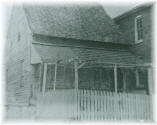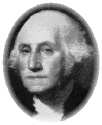 George and Martha
Washington
George and Martha
WashingtonGeorge Washington stopped in Hanover for breakfast in July of 1791. He and Richard McAllister walked down the streets of the town and watched men reaping wheat.
 In
1791 Washington stopped at a Hotel on Frederick Street on his way from
Redford to Philadelphia.
In
1791 Washington stopped at a Hotel on Frederick Street on his way from
Redford to Philadelphia.
Martha Washington stopped here in
 February
of 1778 while returning from a visit with her husband at Valley Forge.
February
of 1778 while returning from a visit with her husband at Valley Forge.
George Ross, one of Pennsylvania's nine Signers of the Declaration of Independence. Locally, he founded in 1762 what was Hanover's first hard industry — the Mary Ann Furnace — which furnished cannon and balls for the Continental Army during the Revolution. The furnace, located 3½ miles south of Hanover, on Furnace Creek. For years it was marked by a plaque placed by the Boy Scouts and Daughters of the American Revolution. The plaque itself was destroyed when Lake Marburg was formed in Codorus State Park. So disappeared almost the last trace of the first furnace in Pennsylvania west of the Susquehanna River.
Ross, a Lancaster attorney, with three partners, acquired four acres known as "Friendship" and erected the furnace in 1762. A year later, when Richard McAllister was laying out his town of Hanover, they petitioned the York Court for a public road from their "furnace lately built at a great expense" to the road from the Conewago Settlement (roughly the Hanover area) to Baltimore. Then in 1766, they again petitioned the court for a road from their furnace to the Monocacy Road at Frederick Eichelberger's tavern on the Hanover-York route. These roads still exist and were important in developing the territory.
Ross moved from Newcastle, Delaware to Lancaster, Pa. when he was admitted to the Philadelphia bar in 1751. From 1768 to 1770 he served in the colonial assembly of Pennsylvania. Here he drew up the declaration of rights which was presented by the assembly to the proprietary government (Penn's). He was voted 150 pounds by Lancaster County for his services in the assembly, but Ross declined to accept. From 1774 to 1777 he was a member of the Continental Congress and as such signed the Declaration.
George Ross may have played another role in the lore of the new nation. He, along with Robert Morris, Benjamin Franklin and George Washington, was on the committee to choose a flag and on June 14, 1777, the Continental Congress declared that the national flag of the United States shall be of stars and stripes, red, white and blue. Mrs. Elizabeth (Betsy) Ross was the seamstress, widow of his nephew, John Ross. She also made flags, and was commissioned for many years to sew flags for the government. Whether she actually made that first flag or not, she is credited in legend for its origin.